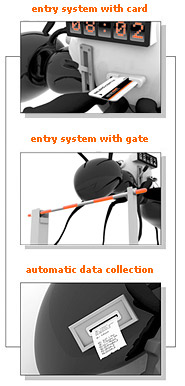
 |
| By using the asystANT GPS module permanent supervision can be realized over the vehicle fleet and the machines. The asystANT system - on the basis of the data provided by the onboard units of vehicles - stores the actual position, direction, speed and other operating data of the vehicles. So the system enables your company to always know where your vehicles are, where your machines work and who the driver is. The onboard unit installed into the vehicles is suitable for RF-card (or PIN-code) identification, so even the start of the vehicle can only be carried out after individual identification. The location and performed route of the vehicles can be traced in a vector-graphical map in the | asystANT system projected to any seconds
(both online and offline). In case of online operation the GPRS-connection
enables the dispatcher-centre to monitor the movement of the vehicle in
"online" on the basis of the GPS-data, which is one of the basic conditions
of dynamic freight management. With the help of this two-directional
communication system the dispatcher informs the driver of the vehicle on
the changed route and the new partner to visit, if necessary. There is an
opportunity to check the pre-determined route and its continuous
planning adjusted to the needs. The asystANT GPS module can also be installed with a 2.4 Ghz wireless |
communication unit, which download the daily
report at the premise in offline mode and can be used for queries of the
data collected and stored in the vehicle. The system can register the
signals of the required metering equipment (probes and security
equipment) and sends immediate warning in case it detects any error,
unauthorized user, unjustified change of level or any deviation from
the determined route. The asystANT system is suitable to keep electronic log books; the general driving behaviour of the certain drivers and the use of vehicles outside the working time can be seen on the basis of the collected data. |
 |
|
|
Functions of the asystANT GPS module: |
 |
| Basic unit: Vehicle unit It is the data collection, registration and mobile communication equipment installed in the vehicle, machine. Its main function is to determine the geographical location and speed, moreover the registration of values received from other supplementary equipment. Further optional supplementary units: RF-card identification It enables the RF-card driver identification and immobilization in case of an unauthorized person. Fuel probe An equipment used for the measurement of atmospheric and overpressure fuel. Thermometer A device used for the registration of temperature data of the load compartment.. Data entry console of vehicles With its help the driver of the vehicle/machine can register data and communicate with the centre. |